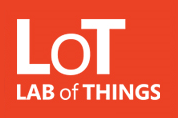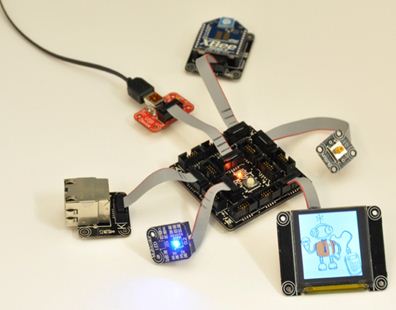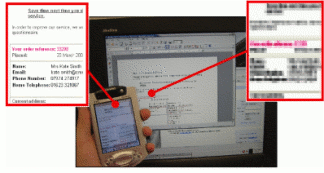Research
Lab of Things
 Lab of Things is a research platform making it easy to deploy experimental user studies in people’s homes. This is built on top of the HomeOS framework, and can incorporate devices built with .NET Gadgeteer.
Lab of Things is a research platform making it easy to deploy experimental user studies in people’s homes. This is built on top of the HomeOS framework, and can incorporate devices built with .NET Gadgeteer.
Rapid Prototyping
 Microsoft .NET Gadgeteer is a platform for rapid prototyping which also has potential in tertiary and secondary education and for hobbyists. By supporting quick and high-level construction and iteration of the hardware, software and physical form factor aspects of a new device, Gadgeteer aims to make prototyping easy, fast and enjoyable.
Microsoft .NET Gadgeteer is a platform for rapid prototyping which also has potential in tertiary and secondary education and for hobbyists. By supporting quick and high-level construction and iteration of the hardware, software and physical form factor aspects of a new device, Gadgeteer aims to make prototyping easy, fast and enjoyable.
Mobile Device Interaction
 I am interested in the area of mobile device interaction. In particular I am looking at new ways for users to provide input for mobile device scenarios where using keyboards/mice are not feasible, such as by sensing physical forces that users can apply to device casings by using the rear of devices for text entry, and using smartphones to extend physical appliance UIs.
I am interested in the area of mobile device interaction. In particular I am looking at new ways for users to provide input for mobile device scenarios where using keyboards/mice are not feasible, such as by sensing physical forces that users can apply to device casings by using the rear of devices for text entry, and using smartphones to extend physical appliance UIs.
Energy
I am also interested in energy efficiency in a broad sense, from reducing the energy needs of computers, particularly those with limited battery resources, to using technology to help reduce our need for energy e.g. by more efficiently heating homes.
PreHeat is a prototype home heating system (deployed in my house!) which uses room-level occupancy sensors to adaptively control heating in each room to minimise energy use while maintaining comfort. Thermal imaging can also be used to infer the most comfortable air temperature for occupants.
 Somniloquy is a system which allows computers to “talk in their sleep” and thereby removes the need for users to leave their computers on while they are absent, either for remote access or to leave background applications running.
Somniloquy is a system which allows computers to “talk in their sleep” and thereby removes the need for users to leave their computers on while they are absent, either for remote access or to leave background applications running.
CABMAN is an architecture allowing mobile devices to monitor their battery level in a more context-aware fashion, thus not bothering the user at inappropriate times, and maintaining better notions of when energy is scarce or abundant.
SenseCam and Privacy
 With the SenseCam wearable camera, I have done some work including thinking about what sensors are best for triggering picture taking, and, on the other side of the coin, in looking at the privacy implications of always-on logging. I have also studied privacy in areas such as location traces and for sharing between coworkers.
With the SenseCam wearable camera, I have done some work including thinking about what sensors are best for triggering picture taking, and, on the other side of the coin, in looking at the privacy implications of always-on logging. I have also studied privacy in areas such as location traces and for sharing between coworkers.
-
Haggle
 The Haggle project explored networking for mobile users using both local peer-to-peer wireless connections as well as infrastructure-based Internet access when available. For example, an email could be transferred by peer-to-peer networking if the recipient is nearby, but today’s software and network architecture do not facilitate this.
The Haggle project explored networking for mobile users using both local peer-to-peer wireless connections as well as infrastructure-based Internet access when available. For example, an email could be transferred by peer-to-peer networking if the recipient is nearby, but today’s software and network architecture do not facilitate this.In Haggle we created a software architecture for mobile devices which seamlessly makes use of both opportunistic peer-to-peer and infrastructure-based networking to meet the data transfer requirements of applications, while also respecting the limited resources of mobile devices.
Secure Mobile Computing
In the secure mobile computing project we looked at how people can make use of public hardware (e.g. internet cafes, situated displays, etc) without exposing themselves to security threats in the form of keylogging, screengrabbing, remote session hijacking, etc. This is achieved using a personal device (e.g. a smart phone) in combination to the public device, where the personal device runs all the user’s applications and censors the output to and input from public devices. The system aims to capture the privacy and trustability of the personal device with the usability of the large input/output hardware of situated devices.
Place Lab
 Place Lab enabled low-cost, easy-to-use device positioning for location-enhanced computing applications. Clients determined their location privately without constant interaction with a central service, by listening for radio beacons such as 802.11 access points, GSM cell phone towers, and fixed Bluetooth devices that already exist in large numbers around us in the environment.
Place Lab enabled low-cost, easy-to-use device positioning for location-enhanced computing applications. Clients determined their location privately without constant interaction with a central service, by listening for radio beacons such as 802.11 access points, GSM cell phone towers, and fixed Bluetooth devices that already exist in large numbers around us in the environment.Place Lab enabled research into a number of location-aware applications, including for social location disclosure, for location-based reminders, and for location-enhanced messaging.
Audio Location
The audio location project looked at the use of commodity audio hardware to perform fine-grained location of people in the environment. Unlike other fine-grained location systems, we used completely off-the-shelf audio hardware. Furthermore, no “tag” device is required for users.
The system operates by detecting sharp noises such as finger clicks, and determining the 3D position of the clicks using a multilateration algorithm. This can be used to construct 3D user interfaces, whereby a person clicking their fingers in a particular region of space might cause actions such as activating a light switch, or controlling a music player.
We have demonstration videos. (Warning: videos are ~35Mb). The audio location prototype was demonstrated at UbiComp 2004 and MobiSys 2004.
Networked Surfaces
My PhD, conducted at the (now renamed) Laboratory for Communication Engineering at the University of Cambridge, was on a radical concept in local area networking known as Networked Surfaces. This network used physical surfaces such as tables or desks to provide connectivity, allowing users to enjoy the convenience and user-friendliness of wireless networking, while also providing the dedicated bandwidth and powering of devices possible with wired networks.
Unlike with cradles, objects could be placed anywhere on a Networked Surface rather than only at a specific location, and the location of objects could be determined to within centimetres, enabling applications such as automatic and dynamic association of devices based on positioning.

